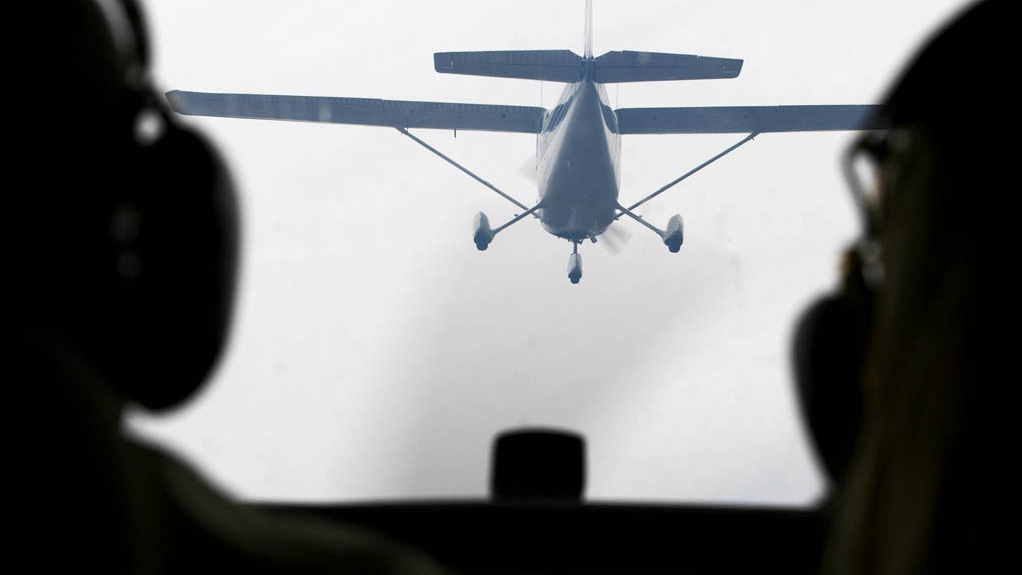Maintaining Separation in Flight
Safety Spotlight: Collision Avoidance

When and Where
Most midair collisions (MACs) occur in day visual meteorological conditions—the times of best visibility—within five miles of an airport. They can also be correlated to traffic levels: most occur between 10 a.m. and 5 p.m. on weekends during the warmer months, essentially when the most traffic is in the air.
Half of all collisions occur in the traffic pattern…check ahead, behind, above, and below your aircraft throughout the traffic pattern and make sure final is clear before turning.Accident Statistics for Collisions
Takeoff and Climb
About one out of 10 midair collisions occur during takeoff and climb, so ensure that the runway is clear before departing and listen for other inbound aircraft. Make position reports and listen for other pilots’ positions reports at nontowered airports. When climbing out use shallow S-turns or lower the nose occasionally to get a better view of the area directly in front of the aircraft.
If you receive a traffic alert or see oncoming traffic, turn on the landing light to make your aircraft easier to spot.Cruise
One quarter of midair collisions occur during cruise flight. According to the National Transportation Safety Board (NTSB), the majority of these accidents result from inattention of the aircrafts’ crews. While cruise flight allows pilots the most time to look for traffic it is also the longest phase of flight and the time of greatest complacency. Scan for traffic and enlist the help of your passengers to spot other aircraft. If possible avoid high traffic areas such as the airspace near navaids and military training routes.
Approach, Descent, and Landing
Half of all collisions occur in the traffic pattern and of these, 80 percent occur during final approach and landing. Check ahead, behind, above, and below your aircraft throughout the traffic pattern and make sure final is clear before turning. Any confusion about where other aircraft are, who’s landing, and in what order can have tragic consequences. This is particularly true at nontowered airports. One may conclude, for example, that no aircraft are in the pattern if there is lack of activity on the frequency. But there may be aircraft operating without radios, or an inbound or outbound aircraft may be transmitting on the wrong frequency.
Early Analysis: Midair Collision at Watsonville Municipal Airport, California
A twin-engine Cessna 340A with two persons on board and a single-engine Cessna 152 with one person on board collided on final approach at Watsonville Municipal Airport in California. The weather was VFR, clear, with 10 miles visibility. Learn more about the tragic accident that killed all three occupants.
Collision Avoidance: See, Sense, Separate
In this video, explore the commonalities among midair collisions and how to minimize risks of being involved in one.
Collision Avoidance Strategies
-
Proper altitude—Adhere to the VFR and IFR cruising altitudes that correspond with your magnetic course. For VFR flights above 3,000 feet agl between zero and 179 degrees, fly altitudes of odd thousands plus 500 (e.g., 5,500 feet msl); between 180 and 359 degrees, fly even thousands plus 500 feet (e.g., 4,500 feet msl). For IFR flights between zero and 179 degrees, fly altitudes of odd thousands (e.g., 5,000 feet msl); between 180 and 359 degrees, fly even thousands (e.g., 4,000 feet msl).
-
Avoid congested airspace—If VFR, avoid overflying approach fixes and navaids as that airspace can get congested. Also, find out which special use airspace along your route is active such as military operations areas and routes, warning areas, and alert areas.
-
Turn on the lights—Even during the day, external lights make the aircraft more visible. Recognition lights increase the aircraft’s visibility to others by a factor of 10. Turn the landing light on during final approach and departure. If you receive a traffic alert or see oncoming traffic, turn on the landing light to make your aircraft easier to spot.
-
Sterile cockpit—The AOPA Air Safety Institute (ASI) recommends that general aviation pilots limit idle conversation during the first and last 10 minutes of each flight in order to concentrate on aircraft operations and scanning for traffic
-
VFR flight following—Request ATC radar advisories and flight following service. While only offered on a workload-permitting basis, ATC may provide another set of watchful eyes.
-
Nontowered airports—Monitor the CTAF and make position reports 10 miles out. Include the airport name at the transmission’s beginning and end. Report each traffic pattern leg while listening and keeping a watchful eye out for other traffic (remember not all aircraft have radios).
